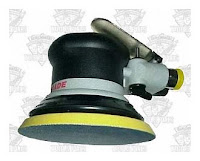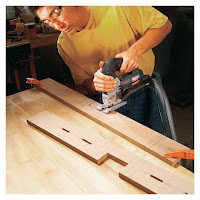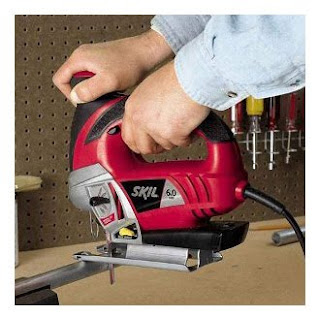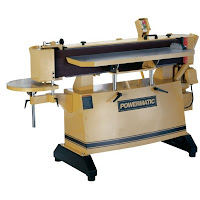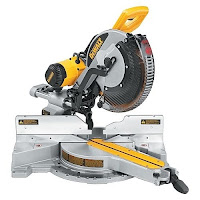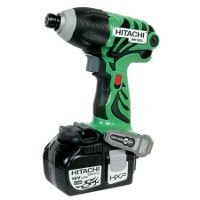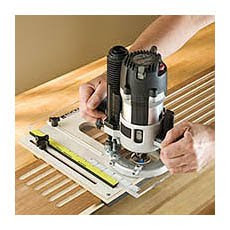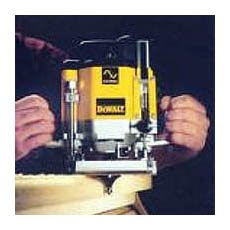My experience in manufacturing fine hardwood furniture has taught me that about half the time involved in producing each chair, table or cabinet is taken up with sanding. When you are trying to make a living in the woodworking business with hourly employees you must cut wasted time to an absolute minimum. This does not mean becoming a slave driver but, rather, removing any and all obstacles that may be slowing down construction, sanding and finishing. I started out my woodworking career with a ¼-sheet electric sander, quickly graduated to a random orbit electric disc sander and finally realized that I could substantially shorten sanding time with an air palm sander. I settled on a 5” Dynabrade sander and Sears 3HP air compressor. It took me less than an hour to realize my mistake: the little compressor I bought could not begin to keep up air demands of the air sander. It would run out of air pressure almost immediately and the air sander would slow down to the point of being useless. I would then have to wait for several minutes for the pressure to build up again to get another minute of sanding.
To make matters worse, I had three employees hired as sanders and so I would need to keep three machines running at top speed all day long. I did some math and discovered that I would need a ten horsepower compressor with a large tank to do this. I was lucky to find a used one for not too much money but it required three phase power and lots of it. More money went out for an electrician to wire it up to the building’s 208 volt 3-phase power. The compressor was so loud it could be heard all over the building and down the block but it powered those three sanders from dawn to dusk. The good news is that it paid for itself in saved sanding time very quickly.
Air sanders are aggressive and efficient. They are light in weight when compared to their lesser electric cousins. My sanders took to them immediately and production took off. I was as happy as they were. Soon there was another machine requiring large amounts of air in the shop: an Onsrud inverted pin router. Plus, it was great to be able to blow sawdust off benches and machines while cleaning upon the shop at the end of the day.
Years later, I built a smaller woodworking shop in my home which only required one sander running at a time. For that shop, I purchased a compressor half the size and isolated in a soundproof room in one corner of the shop. I ran ¾” galvanized pipe under the shop floor to three regulators at three different convenient locations. The machine I purchased for that shop was a 5 HP Ingersoll Rand model with an 80 gallon tank. At the 80 PSI required by my Dynabrade sander, the compressor would produce enough air all day long. I must say that that compressor was very well built. All I had to do was keep an eye on the oil level in the sight glass. At night, I would turn off the master air valve on the side of the machine, leaving the electricity on, to silence the compressor for the night.
I must assume that, having read this far, you have some interest in using an air compressor to power air tools in your shop. There are a few things to consider carefully in selecting the right compressor for your particular needs. As a rule of thumb, a 5 HP air compressor will power one air sander, a 7.5 HP machine will power two and a 10 HP machine will be needed for three sanders.
The size of the tank is an important consideration: the smaller the tank, the more often the compressor will need to cycle on and off and too much of this is hard on the motor and compressor pump over time. I would not even consider an air compressor used to power an air sander with less than a 60 gallon tank and I would feel much more comfortable with an 80 gallon tank.
The type of electrical power required is another consideration. If you have three phase power available at your location, fine. Three phase motors tend to use electricity a bit more efficiently than single phase motors. Large air compressors will all require 3 phase power but the 5 HP models come either way. If you do not have 3 phase power available, you can manufacture it with a rotary or electronic phase converter as I did in my smaller shop. Whether you use single or three phase power, you will need 230V AC power for single phase motors and 208 to 230V AC for the three phase variety. Three phase motors are not as picky about exact voltage as are single-phase models. Be sure to check the voltage and amperage requirements of any air compressor before you buy it. Electricians can be expensive if you don't have the right kind of power already available.
Two-stage compression is a must for a machines of this size. Two-stage machines have two cylinders, one larger than the other. Air is first introduced into the large cylinder where it is partially compressed and sent to the smaller cylinder for final compression into the tank. As air is compressed, heat is produced and so a good machine will always have a finned intercooler built in.
Compression not only produces heat but squeezes water out of the air which ends up in the tank. Tanks can rust internally over time and if this is not kept in check, the air tank an eventually explode causing tremendous damage and even death. That is why it is critically important to drain the accumulated tank water every day. Most machines come equipped with a drain valve at the lowest point of the tank. If you don’t want to spray water all over the floor under the compressor, you may want to consider piping it from the valve to another location such as under the floor or into a drain. Piped water will flow uphill into a sink because it is being pushed out of the tank by compressed air. Fancier models may include an automatic tank drain.
You will need at least one regulator and a water trap in line before it. These are not expensive. A regulator allows you to set the correct air pressure for the tool you will be using (say, 80 PSI) instead of tank pressure (say, 175 PSI).
Air output of a compressor pump is expressed in standard cubic feet per minute (SCFM) or just cubic feet per minute (CFM). Not all 5 HP compressors put out the same volume of air per minute. This is a function not only of motor horsepower but also the efficiency of the compressor pump the motor is powering. The higher the CFM, the less your compressor will have to cycle on and off to keep up with the demands you are putting on it. A small compressor pump on a huge tank will produce no more air than on a small tank. The only difference will be in the number of times the compressor cycles on an off each hour and the time it takes to recompress the tank on each cycle. In the end, you need to pay attention to SCFM (or CFM) more than you do motor horsepower or tank size. Air is the end product of any compressor and the CFM must be sufficient to the job at hand.
All reciprocating air compressors throw out oil with the air they compress. When the tank reaches it’s designed maximum pounds per square inch, a pressure switch will interrupt electrical power to the motor. Simultaneously, a certain amount of oily air will be released into the shop environment. You may see oil collecting on the wall behind the compressor and on the pump and compressor pump over time. This is not cause for alarm but periodic cleaning may be needed.
Reciprocating (piston type) air compressors make noise and this is something you need to plan on for the sake of yourself, your workers and others who surround your location. If quiet is an important criteria, you may want to consider spending the extra money for a screw-type air compressor. Screw-type compressors have no pistons or cylinders. Air is compressed in turbine fashion by a large metal screw, turning at a very high speed. These compressors just purr compared to the reciprocating type but they are very expensive. They sound more like a quiet jet engine than a loud truck motor.
If you are in the market for an air compressor to power your air sanders and other air tools, be sure to check out our reviews of stationary reciprocating compressors from 5 to 10 HP at http://perfectwoodworking.com/aircompressorsreview/. We look at a variety of machines in various sizes from Campbell Hausfeld, Ingersoll Rand, Porter Cable and Quincy.
Bob Gillespie
Woodworker
© 2010 PerfectWoodworking.com
For similar woodworking articles and tool reviews see:
http://www.PerfectWoodworking.com/


